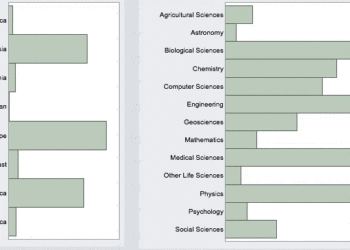
Editor’s Note: Adam Hodgkin first learned about publishing as a philosophy editor at Oxford University Press. He has since founded or co-founded three startups on the boundary between publishing and software. Adam is now the Chairman of London-based Exact Editions, but he has not abandoned philosophy and has a monograph forthcoming with the University of Chicago Press: Following Searle on Twitter: How Words Create Digital Institutions.
Academic and scholarly publishers have gravitated towards an aggregation model of distribution. Journal publishers are in the midst of a period of consolidation, as mergers and acquisitions result in the large publishers combining and growing ever larger. While the world of academic books has not yet been fully swept up by this aggregation fever, there are some potential lessons to be learned and strategies to be considered before the aggregation model is simply copied.
The trail for journals was blazed by the largest STM publishers (Elsevier, Springer, Wiley etc) who have shown that the considerable investment needed to assemble, organize, distribute and reliably support large collections of research publications can lead to both an efficient and a highly profitable business. These publishing aggregations have also shown that they can scale — the centripetal power of these large groupings has encouraged further consolidation and reduced the scope for small learned societies to produce their own digital solutions; it has also give the large publishers considerable pricing power, since in many fields (medicine, mathematics, engineering) research organizations cannot do without their content, and the big-deals have been priced in such a way as to make cherry-picking individual periodicals uneconomic. The momentum and sustainability, year by year, of these content collections has also delivered a reassuring degree of stability to the market — there is no likelihood that these vehicles will be abandoned by their owners when they are so profitable. Concentrating technical resources, distribution and licensing systems, and to an extent user experience and expectations around a few large content silos, has worked for the STM periodicals. Circling the wagons was a shrewd move.
The example of these very successful aggregations of scientific and technical periodicals has understandably fed through to be extended into the social sciences and the humanities, where periodical publications can benefit from the same solutions: an aggregated and searchable database, uniform support, shared infrastructure, automated updates and new issues, common pricing, etc. It was therefore to be expected that academic book publishing would tend to follow in a similar direction, indeed the three or four largest STM periodical publishers have tended to simply ‘plug in’ their books to the existing infrastructure.
The publication of academic, scholarly, social scientific books is not so easily amenable to consolidation and aggregation model. Even if we ignore the rather special requirements and market for academic and college textbooks, the books market as it reaches into university and college libraries is a very heterogenous affair. Scholarly monographs are only a small part of the picture. There are many more publishers involved, many more disciplines and sub-disciplines, and a large but very interesting fringe of books which are by no means exclusively for scholars and students. University libraries need digital versions of many of the ostensibly ‘trade’ books, or special interest books, that may have been primarily written for a popular cultural market. The high granularity of the books market has not stopped large academic book publishers, or consortia of them, from developing their own ‘book platforms’ and to an extent piggy-backing them with an existing periodicals service: Oxford, Cambridge, Wiley (again), Project Muse and JSTOR have launched aggregation solutions for the books market.
It has looked as though the ‘platform’ approach is the best model to adopt — and with a steady, envious and sidelong glance at the way the journal publishers have developed their systems. There are undeniable advantages for the publishers and authors on the one hand; and for the libraries and institutions on the other. For the publishers the advantage is that the process can be designed once and left to run itself — this is what platforms do; for the author there is the assurance that her/his book will reach into all the institutions where the platform has been adopted; and for the library these advantages also accrue (“We only need to worry about 5, 7 or perhaps 10…library supplier book platforms, not the 342 publishers that source our books”), and yes the selection advantage also relieves the acquisitions librarian of some responsibility.
It may well have been another crucial advantage of the platform approach, adopted by the likes of JSTOR, Oxford Scholarship Online (OSO) and their peers, that it has been possible to deliver PDF versions of the books to the subscribing audience. This is in most fields of scholarship an essential requirement because PDFs, faithful to the printed page, are much more needed than the ebook solutions developed primarily for consumer audiences. Kindle-style ebooks are, in many cases, completely inadequate for research work or for teaching — at least they are inadequate for academic works with complex, layout, design, and fixed pagination, required for citations or classroom use. PDF files of books are not completely secure within these aggregators’ walled gardens, but it has been practical to insert some relatively non-intrusive forms of social DRM that discourage excessive leakage.
The STM periodicals market has moved towards increasingly tight consolidation, and a smaller number of players (most recently with the merger of Holtzbrinck and Springer in 2015). Should we expect to see a similar process of aggregation and consolidation in the academic books library market? Would it be feasible for OSO, ProQuest, JSTOR, etc., to gradually, gracefully, swell, merge and grow to supply all or almost all the market? There are some reasons for doubting that this will happen. Books are a more unruly and highly disparate market than the trade in technical literature.
The first problem is that these early stage book platforms have so far only shown that they can serve institutions with college-sized audiences and libraries (professional librarians). They do not have a model for supporting small library sales let alone individual sales — the problem here is that for most of the most important books, publishers do not have an available distribution route, or file format, or selection model, which would support efficient distribution at the kind of prices that academic/professional book markets optimally warrant/demand. High end ebooks and PDF books can be sold and are being sold at prices in the range of $40-80, but in a digital market, for the longer term, that kind of pricing will self-erode through irritation piracy, informal piracy, and then professional piracy. I am sure that I am not the only professional who balks at paying $40 or even $20 for an ebook that I might be willing to buy in print for $40.
The second problem gets back to the interesting fringe that I mentioned earlier. There are very many books with quite high print runs (5,000-25,000 or more) that are of interest to university libraries and should be available across the campus in some digital form. Highly-illustrated books are an obvious example — in many fields of considerable research interest (art, archaeology, botany, history, etc.), but also many quality trade books which may be poorly served by ebook platforms in universities. If there is a satisfactory digital format, or perhaps a subscription vehicle, in which these kinds of books can be sold to individuals and libraries there is a new market to be addressed.
The third problem standing in the way of the steady extension of large-scale content aggregation models is that revenue aggregation tends to reach a limit of scale. Small schools or niche consultancies don’t need enormous libraries (or at least they do not need them if they are required to pay for them). Library requirements tend to reflect institutional requirements, but educational and recreational institutions are so incredibly various in their size, level, budget, and function that aggregation models will not always work. Either the aggregators will learn to offer very small collections or their territory will be nibbled away by niche marketers with dis-aggregation solutions.
Might it happen that these ‘relatively’ large-scale aggregators get over-taken by a super-aggregator? For the sake of the argument, we can suppose that the super aggregator’s name begins with an “A” or a “G” an “F”? While we should not completely discount the possibility that a super-aggregator may emerge, in effect to do a Spotify for digital books, so far we have not seen it (although some of us have not forgotten that there was a big kerfuffle 9 years ago with the “G” company). Even for Amazon, books and ebooks have become almost a side show, and it seems unlikely that the digital books market is of sufficient interest to attract one of the giants. The regulatory attention which would probably follow Google or Amazon if they were dominant in digital book publishing would be highly unwelcome.
For these reasons, I suspect that we may now see a period of interesting growth in which institutional markets for books are explored by platforms that aim to curate, to select, and to support focused collections of books and their use in social and educational settings. One factor that may help a move towards better publisher curation and tighter publisher selection, is that we still have list innovation and support for new focused disciplines from small specialist publishers. If publishers and platforms get developed in ways that can efficiently and standardly serve libraries and schools large and small we would be moving towards an environment in which digital books can be sold in somewhat the same way that print books were sold to libraries 20 years ago: on a title-by-title basis, with small discounts for aggregation but, but with a digital kicker, such that if the book is licensed to an institution, with a network library system within its walls, there should be an FTE based additional charge. We may not yet be ready to uncircle the wagons, but with increasing confidence in digital markets we could be moving in that direction.
Discussion
5 Thoughts on "Guest Post, Adam Hodgkin: Do Books Need More Aggregation or More Curation — Time to Uncircle the Wagons?"
One can look at the e base model used by CRC Press in which one can buy various parts of the engineering books in an e collection.
Springer it appears is putting its entire collection of books and journals in e format.
STEM books are priced high because the markets are so small. Once investment is recovered and some profit made these books can be made available in an e format at a lesser price and still make a dollar or two.
It seems to me that the publisher which manages to integrate books with journals and in so doing creates a database in which one can create one’s own library from the offerings will do very well.
In short, create a database from which individual derivative products can be created.
Maybe the p-market (the number of entities prepared to pay) for STEM books is small because the prices are high? In my experience, the r-market (as in the number of potential readers) for scholarly works is much, much higher than most publishers and authors think. So, the challenge is how to reach the maximum number of readers while earning enough from those prepared to pay.
Thanks to Adam Hodgkin for his thoughtful analysis of an area of great interest and growth among the library community. At JSTOR, where I serve as Director of the three-year old ebook program, we are committed to providing a sustainable aggregation model that integrates ebooks into a researcher’s overall experience. We agree with your comments on the benefits of a consolidated platform approach: our service provides an aggregated and searchable database, uniform support, shared infrastructure, and automated updates and new issues.
I would, however, like to comment on a few points about accessibility of ebooks to smaller libraries and price points. Hodgkin says that “early stage book platforms have so far only shown that they can serve institutions with college-sized audiences and libraries.” We’re pleased to share that more than 400 libraries participating in the Books at JSTOR program are small colleges, community colleges, or secondary schools. All 45,000+ titles in the JSTOR program are available for title-by-title selection and acquisition. We have also found that models like Demand Driven Acquisition (DDA), where libraries pay for what their users consume, have made books from smaller university presses and earlier copyright year books more discoverable and accessible to all libraries. This model allows libraries, regardless of staff size, to support real time demand for students and faculty to conduct research on a consolidated platform of ebooks and journals. Our usage data has shown that by including ebooks on a platform where research is already occurring for journals, ebook usage immediately increases to support the broad research demands of students and faculty. In fact, when institutions have incorporated DDA for ebooks and have archive collections on the JSTOR platform, the percentage of ebook usage on the platform has increased from 7% of overall usage for an institution on the first month they activate DDA to 15% of the overall usage after 12 months. In addition, when an ebook acquisition is triggered in our DDA program (where usage has already occurred to trigger the event), the same ebook on average has 19 additional chapter views and downloads over a 12 month period. There is also a strong correlation with the subjects with highest usage for ebooks and those that already have the highest usage in the archive collections.
At JSTOR, our mission is to drive access to knowledge for the most users at manageable costs. The success of our ebooks program in recent years shows that our library participants, large and small, are eagerly adopting this as both a sustainable and affordable solution.
Frank Smith, JSTOR
Adam’s thoughts are, as always, interesting. However, there might be another dimension to this, namely the attractions of self-publishing and the extent to which this can be accommodated by the evolving market. I have been looking quite closely at this because I am aware, as an author, of a considerable number of potential book projects that do not seem viable for an academic publisher but where technological developments mean that authors could produce print on demand/ebooks of an acceptable design quality. On my estimates, authors could also enjoy a royalty share considerably greater than anything I would be offered from an academic publisher. However, I have not yet been able to see a way around the barriers of marketing and distribution. Put simply, I can write a book and create publication files in a range of formats. I could get this onto Amazon as a distribution channel, although I am not completely comfortable with sitting alongside the online erotica. However, I cannot yet see how to get this to the attention of colleagues and libraries who might buy it. Is there a niche here for a different kind of aggregator, who might exercise some measure of quality control, so this is distinguishable from vanity publishing, but where authors shared the economic risk by assuming responsibility for many of the up-front costs of production?



